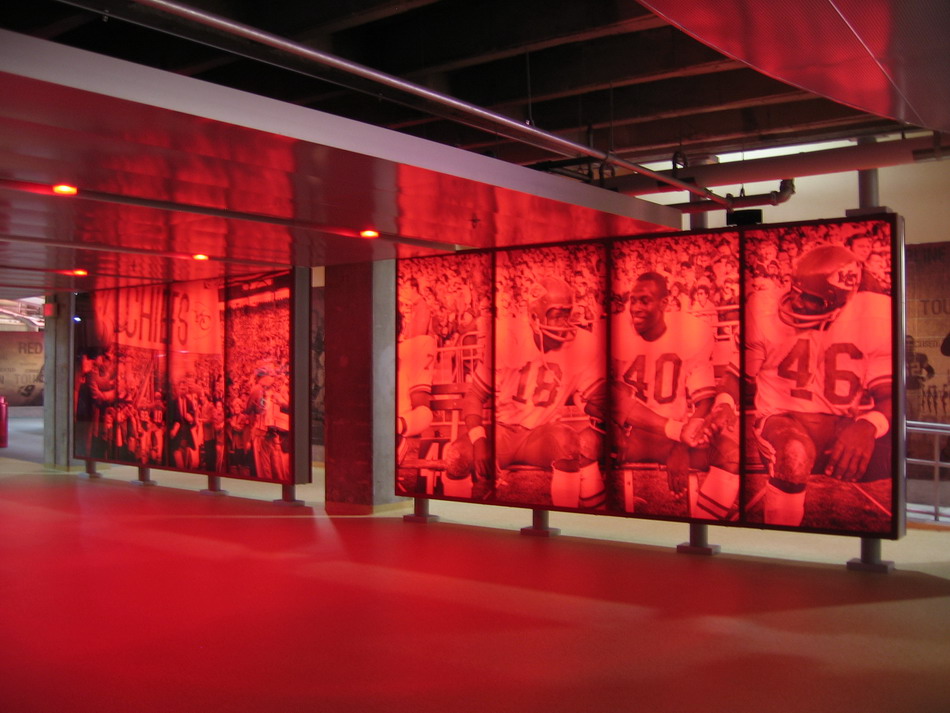In 1963, multimillionaire businessman Lamar Hunt was looking for a place to move his then-Dallas Texans, a member of the fledgling American Football League (AFL), because he believed the city couldn’t financially support both his squad and the NFL’s Cowboys. Thanks to fruitful negotiations between Hunt and Kansas City mayor H. Roe Battle, he moved his team there that year and rechristened them the Chiefs.
For the remainder of that decade, the Chiefs emerged as one of the AFL’s better teams thanks to quarterback Len Dawson, linebacker Willie Lanier and other stars. Thereafter, the team has enjoyed intermittent success with the likes of such star players as linebacker Derrick Thomas, running back Christian Okoye and tight end Tony Gonzalez. However, through thick and thin, Chiefs rooters have remained among the most fervent and devout NFL fans.
As part of a $300 million renovation completed this year, team officials sought to honor the team’s legacy with an extensive sign and wall-graphic program for Arrowhead Stadium, the Chiefs’ home since 1972. After vying with eight other companies, Star Signs (Lawrence, KS) won the project in an open-bid process. The job entails more than 50,000 sq. ft. of graphics that comprises digitally printed wall graphics, flatbed-printed rigid-media graphics, and translucent digital prints applied to acrylic.
Kansas City-based Populous, formerly known as HOK Sport, managed the renovation’s architectural design, and also developed the environmental-graphic package. Star Signs worked closely with Populous to ensure the images matched each signs’ required configuration. Expectedly, project parameters changed constantly, and frequent field verifications were required before production could begin.
According to Shelley Rosdahl, Star Signs’ sales VP, said newly painted walls were allowed six months for the coatings to cure, and all walls to receive graphics were power washed one day in advance, with a thorough wipedown on installation day.
To coat the textured-wall surfaces, the shop printed the graphics with 3M’s IJ8624 rough-surface film on its Mimaki JV3-160SP printer. 3M’s Scotchcal 8524 overlaminate will extend the graphic’s lifespan on the warpath. For images from the team’s early glory days, the designs feature somewhat muted, sepia-toned images with such sports buzzwords as “team” and discipline” emblazoned within the graphics. With renderings of players of more recent vintage, Star Signs produced full-color prints in a similar format.
Advertisement
For rigid-media installations where walls couldn’t take directly applied media, the shop installed flatbed-printed graphics, which Star produced on a Mimaki JV-1631 with 3A Composites’ 4mm-thick E-panel composite material. Wasatch and Onyx Graphics RIPs were used for different aspects of the project.
Throughout several concourses, lightboxes bathe their surroundings with the team’s iconic red color. The renovation’s electrical contractor furnished the fluorescent-lit boxes, and Star bedecked them with translucent 3M film printed on one of the shop’s Mimaki JV-3s and applied second surface on Sabic Polymershapes Lexan® polycarbonate.
“One of the project’s biggest challenges was keeping the outcome consistent across different materials, printers, inks and RIP software,” she said. “Our process required lots of print samples. Also, we had a challenge with determining our application process for the IJ8624 rough-surface film. Because of the large square footage we were covering, we had to carefully coordinate the availability of lifts and equipment for application at each location.”



 Tip Sheet4 days ago
Tip Sheet4 days ago
 Business Management2 weeks ago
Business Management2 weeks ago
 Real Deal5 days ago
Real Deal5 days ago
 Women in Signs2 weeks ago
Women in Signs2 weeks ago
 Benchmarks2 days ago
Benchmarks2 days ago
 Editor's Note1 week ago
Editor's Note1 week ago
 Women in Signs5 days ago
Women in Signs5 days ago
 Line Time2 weeks ago
Line Time2 weeks ago









